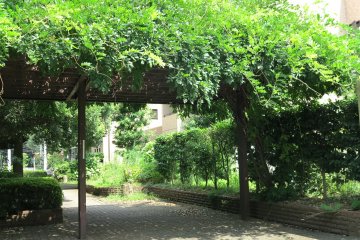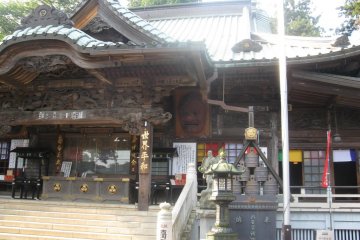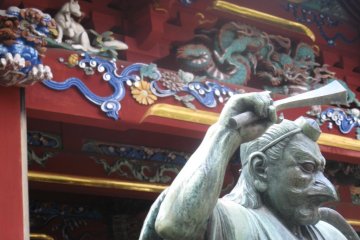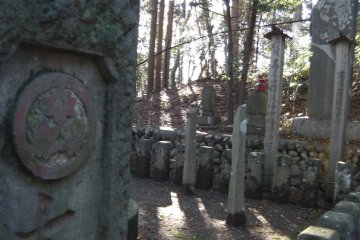Full disclosure: Yakuo-in Temple is my absolute favorite place in Japan. I typically try not to give a five-star review to anything but the best and most famous sites in Japan, but when it comes to this serene location with its beauty and incredible natural backdrop, I can't help but gush.
Formally called "Takao-san Yakuo-in Yuki-ji," this temple features beautifully decorated and colored structures spread across multiple levels on the face of Mt. Takao, a popular mountain for hiking and trekking in western Tokyo. The temple buildings feature intricate carvings and paintings that are unlike the simplistic decorative approach favored by most Japanese temples. Lavish but well short of gaudy, the detail work will leave visitors circling around the backsides of buildings for hours in an effort to see every last section of it. The brilliance of color contrasts the lush greenery of the surrounding mountain forest, and looks especially beautiful when set against the autumn colors. From building to building and even on the stairs between levels, Yakuo-in maintains a powerful serenity that touches its visitors.
The temple was established in the year 744 under the direction of Emperor Shomu, and was founded by the priest Gyoki Bosatsu, who is famously associated with the construction of the Great Buddha statue at Todai-ji in Nara. According to calligraphy inside, the current building is believed to have been constructed in 1648. The principal image of the temple is Izuna Daigongen, a figure comprising of the elements of five deities, who protects and blesses his devotees.
The temple is notable for its depictions of tengu, long-nosed demon-like creatures who act as messengers of deities and chastise evil people while protecting the good. Two tengu are depicted in Yakuo-in: one with a long, pointy nose and the other with a crow's beak. Statues and images of them can be found throughout the temple, including a large facial carving mounted on the front of the Main Hall. They are often shown holding a Japanese fan, which is used to sweep away misfortune. The tengu are believed to live on sacred mountains, and appear in many lore and myths.There are also numerous statues of wolves and wild dogs, which are commonly found in Japanese mountain temples.
Yakuo-in hosts many events and festivals throughout the year. New Year's Day witnesses an event called Geikosai, the festival to welcome the light, which occurs at sunrise and features the magnificent sound of the priests' sutras and conch shells echoing from the mountain. For the Japanese holiday of Setsubun, held on about February 3, people participate in the bean-throwing tradition to cast out bad fortune and welcome good fortune into the home. Sumo wrestlers also participate in the Setsubun activities. The temple also hosts a fire-walking event on the second Sunday in March each year in which the fire's flames are said to burn off the defilement of people's bodies. An autumn festival is held annually on October 17, featuring people and children climbing the mountain in traditional clothing. There are also blessings of cars and their drivers to promote traffic safety, for which applications must be made to the temple by phoning them directly. Many of these events feature a ceremony called Goma, a fire ritual in esoteric Buddhism to lead people to a spiritually higher realm.
Yakuo-in Temple is located on Trail 1, the "Omotesando Trail," which the mountain's website lists as a 100-minute ascent from the bottom to summit, but is of course different from person to person depending on speed and fitness. The temple is located about 10-15 minutes from the mountain's summit, meaning that it can easily be reached on the descent if you take any other trail to the top first. Taking the cable car from the mountain's base leaves only about 10-15 minutes of hiking to reach the temple. It is free of charge to enter.


















